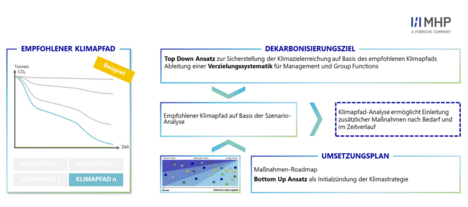
- Blog
- Published on: 13.04.2022
- 3:59 mins
Moving target decarbonization
On the right track with climate paths
The question of how climate change can be stopped before our planet is irreversibly damaged is also a mathematical equation.
The question of how climate change can be stopped before our planet is irreversibly damaged is also a mathematical equation. The starting point is the assumption, based on a broad scientific consensus, that temperatures must not be allowed to rise by more than 1.5 degrees Celsius by 2100 compared to the average pre-industrial value. It is now April 2022 – the “Decade of Action” to meet the Paris climate goals has not just begun, it is in full swing. It was not until November 2021 at COP26 in Glasgow that 197 countries came together to make a clear commitment. To meet this target, only a certain “carbon budget” may be used – no more. Scientists have calculated various scenarios and published the results in the IPCC Report 2021. At the time of publication, around 400 billion tons of CO2 was still available, which corresponds to around 50 tons of CO2 per person. If nothing changes in terms of emissions, this entire allocation will be used up by around 2032.
The period determined by the carbon budget is crucial because many countries and companies have set out targets for reducing emissions – and some are very ambitious. They often refer to the period between 2030 and 2050. To put it bluntly: That is far too late. In this respect, the stakeholders should align their decarbonization target with the carbon budget available to them.
Concrete determination of the own Corporate Carbon Footprint (CCF)
For this purpose, the total budget of 400 billion tons can be distributed: among individual states and, within individual states, among individual sectors such as mobility and industry. Economic climate impact models can help in this step by determining the emission intensity in relation to gross value added (e.g. tons of CO2 emissions per €1 million gross value added). This makes it possible to calculate the amount of emissions that would be emitted in the respective sector if the economic emission intensity of each company were the same. This figure serves as a basis for determining how far the carbon budget has been exceeded, which in turn allows conclusions to be drawn on the achievement or non-achievement of the 1.5-degree target. Companies can use climate impact models to determine their status quo and place this in the overall context of the 1.5-degree target.
To use a climate impact model, the first step is always to determine your own corporate carbon footprint (CCF) – for example, based on the Greenhouse Gas Protocol. In fact, the number of companies in Germany calculating their individual CCF was only around 24 per cent at the beginning of 2021. However, the CCF is becoming increasingly important, not least because of the requirements of various stakeholders.
Existing decarbonization measures for their effectiveness
To comply with the carbon budget set for a company, “climate pathways” should be created in the second step. Climate pathways are various decarbonization scenarios that can be used to check the effectiveness of individual decarbonization measures. Climate impact models can also be used to support this process. For example, these models help to show the individual climate impact of the individual scenarios, considering the carbon budget, making the individual scenarios quantifiable and thus comparable. Specifically, this means that climate impact models enable companies to analyze different climate pathways, define a specific climate pathway and, using a top-down approach, set up an individual decarbonization target system in line with the 1.5-degree target and the carbon budget.
The top-down approach can also be used to validate the effectiveness of existing decarbonization measures and, with the help of a distance-to-target method, to determine whether the planned measures are enough to keep a company on its intended climate pathway. If this is not the case, targeting different areas of the company provides an effective way to develop bottom-up measures that then make an important contribution to decarbonization. In addition to the consistent pursuit of targets, this also lets each employee know that they too can influence the emissions target.
In summary, we have three specific recommendations for you to decarbonize your company effectively and purposefully
In summary, we have three specific recommendations for you to decarbonize your company effectively and purposefully:
- Find out the status quo of your corporate emissions by calculating your corporate carbon footprint and place it in the overall context of the 1.5-degree target. Use climate impact models to determine which climate pathway your company is on.
- Determine and simulate different scenarios for climate pathways and set up a top-down target system for decarbonizing areas of the company. This will help you to economically achieve decarbonization targets for your company in line with the 1.5 degree target and to respond to new findings from scientific climate research that may lead to a “moving target".
- Use the established climate pathway to validate the impact of your existing decarbonization actions, work out your distance-to-target, and use the climate pathway to develop targeted and economically feasible bottom-up actions that close target gaps and pay toward your decarbonization goals.
Defining and simulating climate pathways is an effective way to formulate and reach decarbonization targets that both meet the requirements of the 1.5-degree target and allow the necessary flexibility to adapt your company according to moving targets that emerge from the scientific debate on decarbonization. Let us find the right climate pathway for your company and make the transformation to sustainability economically feasible and targeted. Together we can put your climate pathway into practice – for a better tomorrow!

